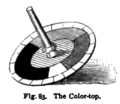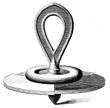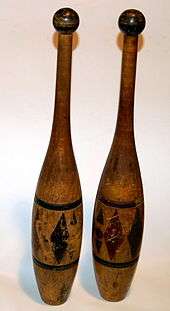Top


A spinning top is a toy designed to spin rapidly on the ground, the motion of which causes it to remain precisely balanced on its tip because of its rotational inertia. Such toys have existed since antiquity. Traditionally tops were constructed of wood, sometimes with an iron tip, and would be set in motion by aid of a string or rope coiled around its axis which, when pulled quickly, caused a rapid unwinding that would set the top in motion. Today they are often built of plastic, and modern materials and manufacturing processes allow tops to be constructed with such precise balance that they can be set in motion by a simple twist of the fingers and twirl of the wrist without need for string or rope.
Characteristics

The motion of a top is produced in the most simple forms by twirling the stem using the fingers. More sophisticated tops are spun by holding the axis firmly while pulling a string or twisting a stick or pushing an auger. In the kinds with an auger, an internal weight rotates, producing an overall circular motion. Some tops can be thrown, while firmly grasping a string that had been tightly wound around the stem, and the centrifugal force generated by the unwinding motion of the string will set them spinning upon touching ground.
The top is one of the oldest recognizable toys found on archaeological sites. Spinning tops originated independently in cultures all over the world.[2] Besides toys, tops have also historically been used for gambling and prophecy. Some role-playing games use tops to augment dice in generating randomized results; it is in this case referred to as a spinner. A thumbtack may also be made to spin on the same principles. Gould mentions maple seeds, celts (leading to rattlebacks), the fire-drill, the spindle whorl, and the potter's wheel as possible predecessors to the top, which he assumes was invented or discovered multiple times in multiple places.[3]
The action of a top is described by equations of rigid body dynamics (see the section Rotation in three dimensions). Typically the top will at first wobble until the shape of the tip and its interaction with the surface force it upright; contrary to what is sometimes assumed, longstanding scientific studies (and easy experimentations reproducible by anyone) show that less friction increases the time before the upright position is reached (unless the top is so unbalanced that it falls before reaching it).[4] After spinning upright (in the so-called "sleep" position) for an extended period, the angular momentum will gradually lessen (mainly due to friction), leading to ever increasing precession, finally causing the top to topple in a frequently violent last thrash. In the "sleep" period, and only in it, provided it is ever reached, less friction means longer "sleep" time (whence the common error that less friction implies longer global spinning time)
There have been many developments within the technology of the top. Bearing tops, with a tip made of a small hard ceramic, tungsten carbide or even ruby ball (sometimes wrongly believed to spin with respect to the body of the top), have been one of the biggest changes. In addition, plastic and metal have largely supplanted the use of wood in tops. Fixed tip tops are featured in National Championships in Chico, California and in the World Championships in Orlando, Florida.
The following two well-known characteristics of a top that increase its global spinning time ([4]) are exploited in various ways in such championships and by the main top makers (obviously, an optimisation of both characteristics has to be somehow restricted by conditions on mass and/or diameter and by practical considerations about the rim not touching the spinning surface too early):
- low center of gravity
- high moment of inertia
A top may also be used to demonstrate visual properties, such as by James David Forbes and James Clerk Maxwell in Maxwell's disc (see color triangle). By rapidly spinning the top, Forbes created the illusion of a single color that was a mixture of the primaries:[5]
[The] experiments of Professor J. D. Forbes, which I witnessed in 1849… [established] that blue and yellow do not make green, but a pinkish tint, when neither prevails in the combination…[and the] result of mixing yellow and blue was, I believe, not previously known.
— James Clerk Maxwell, Experiments on colour, as perceived by the eye, with remarks on colour-blindness (1855), Transactions of the Royal Society of Edinburgh
Maxwell took this a step further by using a circular scale around the rim with which to measure the ratios of the primaries, choosing vermilion (V), emerald (EG), and ultramarine (U).[6]
Asymmetric tops of virtually any shape can also be created and designed to balance.[7]
Notable types
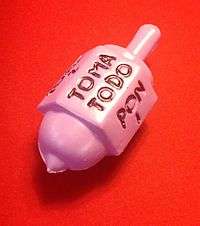
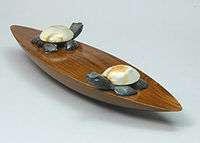
Gould lists the six main types of tops as the twirler, supported top, peg-top, whip-top, buzzer, and yo-yo.[8]
- Competing tops
- Gaming and other tops
- Dreidel
- Bhawra
- Bambaram
- Gyroscope
- Levitating top, based on the interaction between gravitational, electromagnetic and gyroscopic forces (the equilibrium position is hard to find)
find)
In popular culture
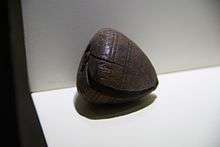
The Jean Shepherd story "Scut Farkas and the Murderous Mariah" revolves around top-spinning in the fictional Depression-era American city of Hohman, Indiana. The bully and the named top in the title are challenged by Shepherd's ongoing protagonist Ralph and a so-called "gypsy top" of similar design to Mariah named Wolf.[10]
The Top is a short story by Czech writer Franz Kafka.
See also
References
- ↑ "Gyro-top to stop: Maker closing shop". The Japan News. February 22, 2015. Archived from the original on February 23, 2015. (subscription required)
- ↑ D. W. Gould (1973). The Top. NY: Clarkson Potter. ISBN 0-517-50416-2.
- ↑ Gould (1973), p.20-4.
- 1 2 H. Crabtree (1909). An Elementary Treatment of the Theory of Spinning Tops and Gyroscopic Motion. London: Longman, Green and C.
- ↑ Peter Michael Harman (1998). The Natural Philosophy of James Clerk Maxwell. Cambridge University Press. ISBN 0-521-00585-X. Archived from the original on 2017-12-27.
- ↑ James Clerk Maxwell (2003). The Scientific Papers of James Clerk Maxwell. Dover Publications. ISBN 0-486-49560-4. Archived from the original on 2017-12-27.
- ↑ Bächer, Moritz; Whiting, Emily; Bickel, Bernd; Sorkine-Hornung, Olga (August 10–14, 2014). "Spin-It: Optimizing Moment of Inertia for Spinnable Objects" (PDF). ACM Conference on Computer Graphics & Interactive Techniques (SIGGRAPH) 2014. Archived (PDF) from the original on 10 August 2014. Retrieved 15 August 2014.
- ↑ Gould (1973), p.32.
- ↑ National Recreation Association (1965). Recreation. p. 92. Archived from the original on 2013-11-13.
- ↑ Shepherd, Jean. "Scut Farkas and the Murderous Mariah", Wanda Hickey's Night of Golden Memories and Other Disasters (New York: Doubleday Dolphin Books), 1976 ISBN 0-385-11632-2
Further reading
| Wikimedia Commons has media related to Spinning top. |
| Wikisource has the text of the 1911 Encyclopædia Britannica article Top. |
- Crabtree, H. "An Elementary Treatment of the Theory of Spinning Tops and Gyroscopic Motion". Longman, Green and C), 1909. Reprinted by Michigan Historical Reprint Series.
- Perry J. "Spinning Tops". London Society for Promoting Christian Knowledge, 1870. Reprinted by Project Gutemberg ebook, 2010.
- Provatidis, Christopher, G. (2012). Revisiting the Spinning Top, International Journal of Materials and Mechanical Engineering, Vol. 1, No. 4, pp. 71–88, open access at http://www.ijm-me.org/Download.aspx?ID=2316 (ISSN Online: 2164-280X, ISSN Print: 2162-0695)
- A forum discussing all things related to the art of Top Spinning: iTopSpin.com

